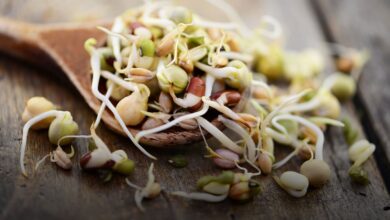Discover the amazing benefits of asparagus for your health

When the first days of spring begin, the availability of new fruits and vegetables becomes a real joy. Among them is asparagus, which appears from April to June. Asparagus is a vegetable plant that grows underground and lets its stem extend toward the sky to find sunlight.
It is grown on French territory, especially around the Mediterranean basin, in Alsace and Val-de-Loire. Long considered a prestigious and luxury item, today it has become widely popular. This is not surprising because asparagus and its distinctive taste offer many possible recipes as well as exceptional nutritional virtues.
Items
Depending on its exposure to the sun, asparagus comes in three different colors:
- white: It is the most cultivated and therefore the most common. Grows protected from air and light. This method of cultivation is called “poteh”.
- Violet: It takes on this color when it penetrates the ground. It is very similar to white asparagus in flavor and texture.
- green: The smaller, finer green asparagus plant grown outdoors. Thanks to the process of photosynthesis, they can produce chlorophyll and become colorful. It has the strongest taste.
There are some tips to follow to choose them very fresh. Its stem should be firm, straight, and almost brittle. Bud scales should be tight and narrow. The heel should be damp and slightly shiny. Often they are offered in packages, it is recommended to inspect each one carefully to avoid the mistake of spoiling them too quickly.
Asparagus can only keep for a few days in the refrigerator. Wrap it in a well-moistened cloth, then place it in the vegetable drawer designated for this purpose. If it starts to become less firm and softened, it is no longer truly fresh.
So it's best to prepare it quickly as soon as you buy it. Frozen asparagus is generally of very good quality, because it is very fresh when frozen. As for canned goods, they can satisfy everyone's taste requirements of course. However, it is true that they are in no way comparable to fresh foods, either in terms of texture and nutritional richness, or in terms of pleasure in the mouth.
Nutritional composition
Asparagus is a vegetable rich in water (92%) and very low in calories. Its energy value is 20 calories per 100 grams on average. Although they are low in energy, they have a big advantage: high nutritional density. In other words, although asparagus is small, it contains an incredible concentration of nutrients, vitamins and minerals.
- In terms of nutrients, its carbohydrate content is about 4 grams per 100 grams. It is a mixture of fructose and glucose, and is ultimately similar to that found in other fresh vegetables. The same applies to fats present in very small amounts (>0.2 g). On the other hand, asparagus stands out more for the amount of proteins and sulfur derivatives: 2.3 grams on average per 100 grams. There are many amino acids such as aspartic acid or even the essential methionine, which are known for their ability to care for cuticles and skin.
- Its fiber content is also particularly interesting for maintaining good health of the intestinal flora. Thanks to the mixture of pectin, mucilage and cellulose, asparagus helps regulate transit and combat constipation, without irritating the mucous membranes. Quantity: 2 grams per 100 grams.
- It also provides many vitamins: vitamin C, provitamin A, vitamin E, vitamin K, and vitamin B9 (folic acid). It is one of the best vegetables containing B group vitamins (B3, B5, etc.). Multivitamin profile contributes to the proper functioning of the immune system. It also helps prevent some cardiovascular diseases, some types of cancer, cell aging and better fight inflammation.
- On the same note, many minerals are concentrated there: potassium, calcium, magnesium, phosphorus, vegetable iron, copper, zinc… The particularly low sodium level makes the potassium/sodium ratio high and beneficial for our cells. That's not all: there are also many antioxidants such as quercetin and saponins, with anti-inflammatory properties that protect the immune system and can relieve allergies.
This nutritional treasure makes asparagus an exceptional food. Its entire formula offers tremendous benefits, including one above all: a proven diuretic effect. It stimulates the elimination of toxins through the kidneys, fights water retention and excess salt trapped in the tissues. Therefore, asparagus has interesting drainage and diuretic properties to purify the body.
This is also another peculiarity of this plant. When eating, urine may become foul-smelling. This smell results from the decomposition and removal of some of the sulfuric substances present in it. Yes, it can be very annoying, especially since moderate consumption is enough. Staying well hydrated is essential and simply wait for it to pass.
Image rights © Adobe Stock
Asparagus in cooking
Asparagus must first be peeled and then cooked (or boiled for a few minutes) so that it can be enjoyable to devour. In water or steam for about fifteen minutes, in the oven or even in a frying pan, many recipes can be prepared using this healthy ingredient. It is an absolute highlight, as it is as delicious hot as it is cold, as a starter or main course.
Or even warm, served with a citrus vinaigrette or mayonnaise, mixed wonderfully with poached eggs or tossed nicely on an omelet. Another delicate mixture, you can just sprinkle it with a little Parmesan shavings, it's amazing.
They are excellent in salads, in the garden with other seasonal vegetables, or on their own with a pinch of salt.
Consuming it hot with cream or velouté, for example, turns it into a wonderful detox soup. Green or white asparagus will be equally succulent for this recipe.
Other culinary delights Crumble asparagus to enhance its texture. As in pie, gratin or quiche, asparagus goes very nicely with meat or poultry.
Asparagus has everything to be delicious if it is well chosen and seasoned with taste. Herbs, spices, garlic and onions go great with it. To whet your appetite, just think about it, a plate of spaghetti with green asparagus with Italian burrata is enough to conquer any taste buds.
Its consumption is highly recommended to relieve temporary or chronic digestive fatigue, to prevent complications of an unbalanced and overly rich diet, or to fight inflammatory disorders and joint pain. Naturally draining, asparagus provides a beautiful seasonal transition for a lively organism. All great grounds to take advantage of once the sunny days arrive.
Discover the amazing benefits of asparagus for your health


